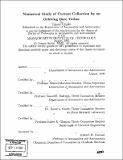| dc.contributor.advisor | Manuel Martínez-Sánchez. | en_US |
| dc.contributor.author | Onishi, Tatsuo | en_US |
| dc.contributor.other | Massachusetts Institute of Technology. Dept. of Aeronautics and Astronautics. | en_US |
| dc.date.accessioned | 2006-03-24T16:21:52Z | |
| dc.date.available | 2006-03-24T16:21:52Z | |
| dc.date.copyright | 2002 | en_US |
| dc.date.issued | 2002 | en_US |
| dc.identifier.uri | http://hdl.handle.net/1721.1/29748 | |
| dc.description | Thesis (Ph. D.)--Massachusetts Institute of Technology, Dept. of Aeronautics and Astronautics, 2002. | en_US |
| dc.description | Includes bibliographical references (p. 183-186). | en_US |
| dc.description.abstract | An electrodynamic (ED) Tether is a long thin conductive string deployed from a spacecraft. A part of the ED tether near one end is rendered positive with respect to the ambient plasma. This positive potential is maintained by the motion-induced Electromotive Force (EMF) or by the power supply, depending on the application of the ED tether. Some part of the positively biased tether is uninsulated and exposed to the ambient plasma, collecting ionospheric electrons. Collected electrons are driven as a current inside the tether and emitted from the other end. The current interacts with the geomagnetic field and produces Lorentz force (forward or backward). Drag force is obtained by deploying the tether upwards and collecting electrons through the part near the top end. Thrust is instead obtained by deploying downwards, applying a power supply to reverse the current and collecting electrons at the bottom end. An ED tether travels in LEO under mesothermal conditions, meaning that the electron thermal velocity is much faster than the tether's orbital speed whereas the ion thermal velocity is much slower. In the frame of reference moving with the tether, ions approach the tether at hypersonic speed, get deflected by the very large positive potential on the tether and create a wake behind it. Due to the asymmetry of the plasma distribution, the conventional probe theory becomes almost inapplicable. The asymmetric and non-stable plasma conditions entail the necessity of computational work for the prediction of current collection. A numerical code using a Particle-In-Cell (PIC) method is developed to calculate the electron current collection to a positively charged electrodynamic bare tether. | en_US |
| dc.description.abstract | (cont.) In order to improve the quantitative accuracy, a new treatment of boundary condition, which utilizes the quasi-neutrality condition of plasma, has been introduced. This condition has been tested and shown elsewhere to give a good quantitative approximation to a current collection calculation to a cylindrical probe in a quiescent unmagnetized plasma. In this thesis, the flowing and magnetic effects as seen in the actual plasma environment are incorporated. Calculations for a list of cases with different plasma parameters are performed and compiled so as to provide the pre-flight prediction of the NASA space experiment called ProSEDS, which is planned to be launched Fall 2002. There is an existing theory called the Orbital-Motion-Limit (OML) theory, which gives the upper limit of the current collection in steady state. The results show that the current collection is higher in some cases than the 2D OML current by a factor of 2 - 3. We discuss the applicability of the 3D OML theory, which gives a higher limit, to the geometrically 2D problem. The justification is given by the detailed examination of individual particle trajectories. | en_US |
| dc.description.statementofresponsibility | by Tatsuo Onishi. | en_US |
| dc.format.extent | 186 p. | en_US |
| dc.format.extent | 7698028 bytes | |
| dc.format.extent | 7697836 bytes | |
| dc.format.mimetype | application/pdf | |
| dc.format.mimetype | application/pdf | |
| dc.language.iso | eng | en_US |
| dc.publisher | Massachusetts Institute of Technology | en_US |
| dc.rights | M.I.T. theses are protected by copyright. They may be viewed from this source for any purpose, but reproduction or distribution in any format is prohibited without written permission. See provided URL for inquiries about permission. | en_US |
| dc.rights.uri | http://dspace.mit.edu/handle/1721.1/7582 | |
| dc.subject | Aeronautics and Astronautics. | en_US |
| dc.title | Numerical study of current collection by an orbiting bare tether | en_US |
| dc.type | Thesis | en_US |
| dc.description.degree | Ph.D. | en_US |
| dc.contributor.department | Massachusetts Institute of Technology. Department of Aeronautics and Astronautics | |
| dc.identifier.oclc | 54402271 | en_US |
